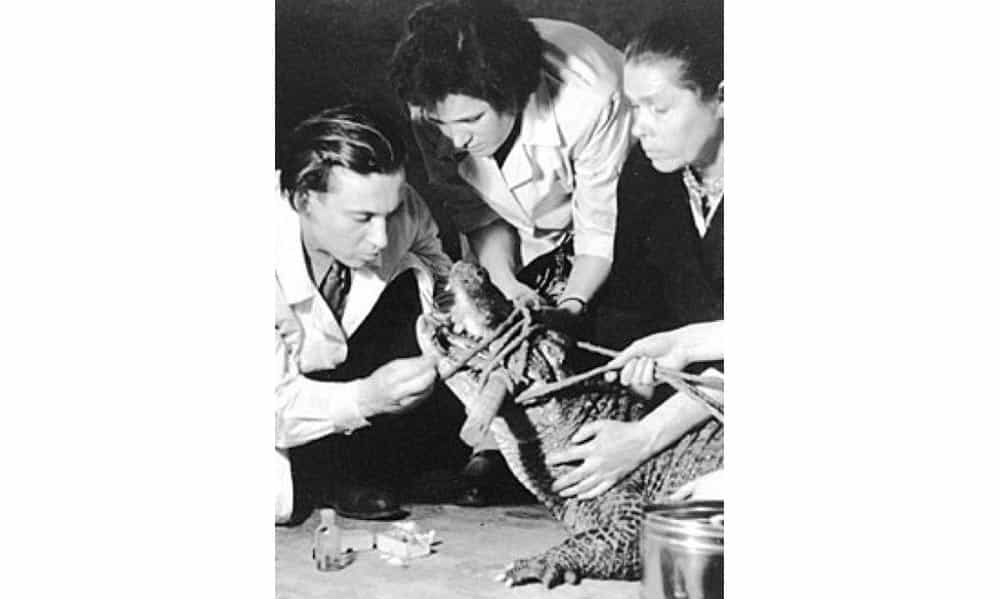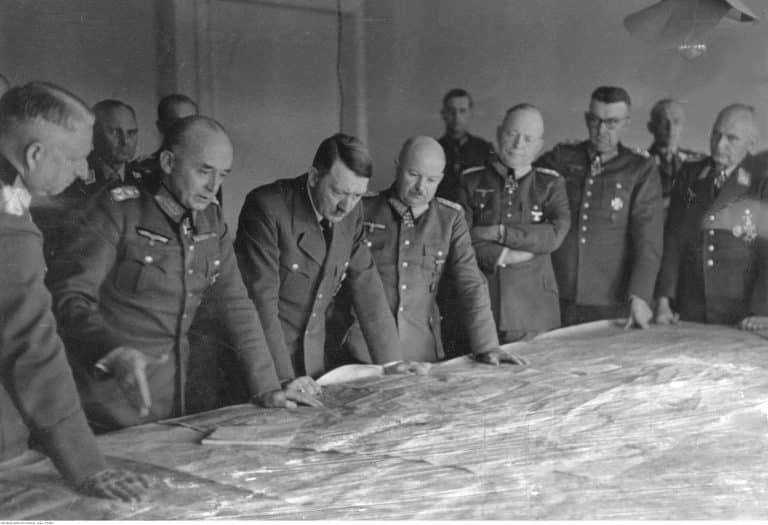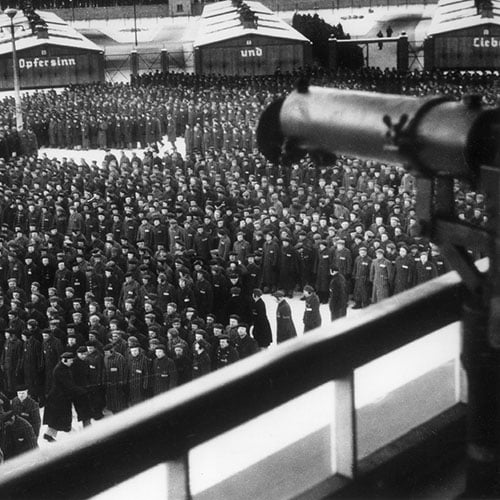In a landmark article printed in the American Journal of Psychiatry in 1963, forensic psychiatrist John Macdonald first proposed the existence of three factors that would come to be known as the triad of sociopathy, or the homicidal triad. The presence of two out of three of these factors in childhood being considered to be predictive of the development of homicidal, sociopathic, or psychopathic tendencies later in life.
Macdonald’s article, titled ‘The Threat To Kill’, theorised that a youthful fascination with starting fires, persistent bedwetting beyond a certain age, and cruelty towards animals are all precursors to potential violence towards humans and psychopathic behaviour.
The understanding that one factor in particular, intentional animal torture and cruelty (IATC) – as it is currently commonly referred to in psychological literature – is a stepping stone to inflicting harm to humans is popular knowledge.
Macdonald’s theory of the homicidal triad remains an influential and widely taught hypothesis. But this particular aspect understandably receives more focus than the two other factors, as it is infinitely more shocking.
In the United States, the Federal Bureau of Investigation (FBI) profiling unit has, since behavioural profiling began to emerge in the 1970s, consistently highlighted that animal cruelty is common behaviour among serial murderers and rapists.
Charles Manson, Edmund Kemper, Jeffrey Dahmer… In the UK, Jamie Bulger’s murderer, Robert Thompson, abused household pets; Moors murderer, Ian Brady, killed animals in his youth; and child killer, Mary Bell – the subject of two books by Austrian-British author Gitta Sereny – was known to torture pigeons to death.
The list goes on.
Sereny spent her entire professional career contending with the question of why people are motivated to commit acts of cruelty and examining the phenomenon of the immoral act. Many of her works could be summarised as an exploration of the eternal moral dilemma as expressed by St. Paul in the Bible: “For the good that I would, I do not: but the evil which I would not, that I do”.
Reconciling the ideas of good and evil in the face of the ‘ordinary’ aspects of the lives of the men who committed the Holocaust and launched Germany into an imperial crusade based on racial pseudoscience has provided many unanswerable questions.
For the men who committed the Holocaust also played with their children, kissed their wives, and petted their dogs.
Perhaps the exception to Macdonald’s rule connecting homicidal behaviour with abuse of animals, animal welfare was seen as a high priority by the Nazi government – in some ways an essential part of the Nazi Party political platform.
–

The Führer's Furry Friends
Not only was Adolf Hilter himself a vocal advocate for animal rights, rarely far from his beloved German shepherd – Blondi – but his regime was also groundbreaking in the progress it made instituting laws that made the animal: “an object of protection going far beyond the hitherto existing law” (“Objekt eines weit über die bisherigen Bestimmungen hinausgehenden Schutzes”), according to the Reichstierschutzgesetz (Reich Animal Protection Act) of November 1933.
Germany, for instance, became the first nation to ban vivisection in August 1933.
A year after seizing power, Nazi Germany hosted an international conference on animal welfare in Berlin the likes of which had never been seen before.
Restrictions on hunting were introduced by Prussian prime minister, Herman Göring; commercial trapping was banned; as was the boiling of lobsters and crab.
Nazi Germany even became the first state in the world to place the wolf under protection.
Although progressive, these laws, of course, were also hardly free from the rationale of National Socialist ideology. Hermann Göring was not only prime minister of Prussia, he was also Reich Master of the Hunt and Master of the German Forests. His prohibitions on hunting underpinned by that quintessentially Nazi logic of do-as-i-say rather than do-as-i-do. Hunting may have been heavily restricted for the ordinary citizen, but Göring hardly considered himself ordinary.
Not long before the prohibition of vivisection, a regulation concerning the slaughter of animals was introduced – specifically targeting kosher butchering.
No animals were to be slaughtered without anesthetic.
This law, introduced in 1933, naturally has to be considered in light of the objection-free approach to the use of concentration camp prisoners to conduct medical experiments. Jews, for instance, may have also loved their pets – as painfully illustrated in Victor Klemperer’s diaries, where Klemperer dwells on the terrible realisation that he will have to give away his cat when felines are declared Aryan by the Nazi state and only for ‘true German’ households – but that does not mean that they are free from being treated worse than animals.
Of all the images available, it is significant that Heinrich Hoffmann – the Nazi leader’s personal photographer, tasked with propagating the ‘Hitler Myth’ – would choose one of Hitler accompanied by a sheepdog in the mountains for the dust jacket of the important propaganda book ‘Hitler like nobody knows him’ in 1932.
The natural political order expressed by the Nazi Party would be presented alongside an image of the natural order of nature.
What better illustration of this than the Nazi leader depicted alongside his favourite companion.
Loyal, obedient, and ferociously protective of its owner.
Although Hitler’s dog Blondi, given to him in 1941 by his loyal assistant Martin Bormann, has become his most recognised canine companion, he did in-fact have a number of German shepherds – including one acquired in 1921, during his years of poverty. The loss of the stray Fox Terrier named Fuchsl he rescued whilst serving in the First World War he would later reference as being one of the most distressing experiences of his time in the trenches.
The vile – just as much as the virtuous – can be pet people too.
–

See You Later Alligator
As Nazi control of Germany turned into a concerted attempt to subjugate the European continent, matters of cruelty against animals – and the manner in which animals are butchered – would take a backseat to the practical issue of survival.
Rationing would become more restrictive, and by the time the Soviet army reached Berlin in April 1945, the slaughter of horses on the street for meat would become a common sight. The more dangerous animals at the Berlin Zoo would even be euthanized in case they managed to escape and attack the people in the city.
In 1943, a rather peculiar incident occurred at the Zoo in west Berlin.
A British raid had heavily damaged the crocodile enclosure, killing at least four of the alligators and crocodiles, and littering the streets near the aquarium with animal remains. The resourceful zoo employees were quick to make alligator stew out of the left-over meat that lasted for the next two days but those that survived the bombing were found prowling the area looking for food.
It is thought that one of these alligators – known as Saturn – said to have been given to the city in 1936, after hatching in the wild in the US state of Mississippi, would end up surviving the war and live until his 80s – becoming the so-called ‘last German in Russian captivity’.
In 1945, the Berlin Zoo ended up in the British Occupation Zone of the city. At some point, British soldiers are said to have discovered Saturn – presumably still wandering around the street of the city – and decided to give him to the zoo in Leipzig, part of the Soviet Occupation Zone of Germany.
From there Saturn ended up in the Moscow zoo, where the rumour of his connection to Adolf Hitler took off.
Cold-blooded, predatory, and prone to insincere displays of emotion, it is easy to see why the crocodile might easily be considered the Nazi leader’s spirit animal. The alligator is a close relative to the crocodile, with the two defined as much by their similarities as their differences, but is the distinction really necessary here?
The idea that Hitler and Saturn might have been personally acquainted and shared a special connection would prove too attractive to ignore.
Even when there is no evidence of the two having ever met.
Saturn lived in Moscow from 1946 until 2020 – thought to have reached an incredible 84 years old.
His death would be reported internationally with indication that the reptile had in someway belonged to the Nazi leader. The Moscow zoo webpage that previously described the alligator’s relationship with Hitler is now offline. It is now suggested elsewhere that Hitler visited the Berlin Zoo a number of times, and possibly saw the alligator. Thus the two were acquaintances. A tenuous connection at best. There exists, however, no evidence to suggest that Saturn belonged to the Führer, as has been rumoured.
The records of the Moscow Zoo were destroyed in the 1950s during a fire, so there remains no documentation of Saturn’s journey to Russia from Berlin. Similarly the records of the Berlin Zoo did not survive the Second World War, so it unknown what sort of life Saturn had during the Nazi period, beyond his possible escape in 1943.
It was not until the 1950s that the aquarium was re-opened – and a Mississippi alligator named Snappy introduced as the first resident in the new Crocodile Pit.
The post-war part of Saturn’s biography, put forward by the Moscow Zoo, suggests that he was a gift from the Brits – but it is entirely possible that he was relocated to Leipzig after the attack in 1943 and made his way to Moscow from there.
Relations between Great Britain and the Soviet Union were not great in 1946 and there is little reason why the British would want to give an alligator – that they are suspected of having found somewhere in Berlin – to Stalin.
The long-time archivist of the Berlin Zoo, Dietmar Jarofke, believes it is possible that Saturn comes from a private collection, saying: “Back then there were enough crazy people in Berlin who kept animals like this at home. It wasn’t forbidden.”
The bigger question here is where did this rumour of the Hitler-Saturn connection come from – and why? Certainly it wouldn’t be beyond the realm of understanding for the Moscow Zoo to simply connect the dots – that Saturn came from Berlin and had been there in the 1930s and 40s; adding the claim that Hitler would have been aware of his presence.
The rumour no doubt helped increase ticket sales.
Such a shame to think that this poor innocent alligator might be cast the villain of his aquarium habitat – held accountable for the deeds of a man he had likely never met. The veritable scapegoat of the Moscow zoo – in reptilian form.
Does inaccurately associating Saturn with Hitler not constitute some form of animal abuse in-and-of-itself?
For that matter, what condemnation should there be of those who exploit the reputation of this poor alligator – reducing him to an object of morbid curiosity and suspicion, at best – for profit?
Certainly, Hitler himself was aware of the significance of what an animal was as much of what it meant.
It is no surprise that, although there exists no documented connection to Saturn the alligator, the Nazi leader should so obviously favour German shepherd dogs. Considering they were coveted as “germanische Urhunde” (original German dogs) during the so-called Third Reich.
**
Conclusion
Saturn, the alligator kept in the Moscow Zoo after the Second World War was often referred to in the press as ‘Hitler’s Alligator”, however, there is no proof the two ever met let alone did the alligator belong to Hitler personally.
***
HISTORICAL ARTICLES
Mythbusting Berlin

Did Any Of The Rothschild Dynasty Die In The Holocaust? – Mythbusting Berlin
The Rothschild name is synonymous with immense wealth, influence, and persistent conspiracy theories—especially during the era of Nazi Germany. Often targeted by antisemitic propaganda, the family’s survival during World War II has sparked myths about their supposed immunity from Nazi persecution. But did any Rothschild family member actually perish in the Holocaust? This article explores that compelling question, unraveling historical misconceptions and revealing the reality behind one of Europe’s most famous dynasties.

Did Frederick The Great Introduce The Potato To Germany? – Mythbusting Berlin
One of the more bizarre claims to fame attributed to the first King of Prussia is that the man who would go down in history known as Frederick the Great introduced the potato to Germany during his reign back in the 1700s. This starchy root vegetable has undoubtedly become a staple part of German cuisine – an essential addition to any plate of Schnitzel, Schweinshaxn, and Königsberger Klopse – however, whether Frederick the Great is

Did Hitler Escape To Argentina In 1945? – Mythbusting Berlin
Although Nazi leader, Adolf Hitler, certainly remains an inescapable figure, could there be any truth to the story of his escape to Argentina in 1945? That the most wanted man on earth could simply vanish, to spend the rest of his life peacefully in South American obscurity captivates imaginations. Yet, despite numerous investigations, this tale persists primarily as myth—fueled by speculation, hearsay, and conspiracy theories.

Did The Nazis Invent Decaf Coffee? – Mythbusting Berlin
Persistent rumors claim that Nazis preferred their coffee anything but pure, leading some to wonder if they might have influenced the development of decaffeinated coffee. Although decaf was already widely available across Europe by the mid-20th century, speculation continues: could the Nazis really have played a role in popularizing—or even discovering—this caffeine-free alternative, or is this simply another caffeinated conspiracy cooked up to sensationalize an ordinary historical detail?

Did The Nazis Invent The Bicycle Reflector? – Mythbusting Berlin
The fruits of wartime ingenuity are plenty – so many, in-fact, that it has become somewhat of a worn cliche that as the guns start firing the innovators get to work, often solving problems while providing more problems for the enemy to overcome.The kind of progress that results in the production of newer improved, more lethal weapons, such as to increase the chances of victory.

Did The Nazis Run The Largest Counterfeiting Operation In History – Mythbusting Berlin
During the Second World War the Nazis masterminded an astonishing plot to destabilise Britain by flooding its economy with counterfeit banknotes. Crafted in secret by concentration camp prisoners, this forged fortune became the most ambitious counterfeiting operation ever attempted. But was it history’s largest? Dive into the extraordinary tale of Operation Bernhard,
rife with deception, survival, and intrigue—revealing the truth behind one of the Third Reich’s most audacious schemes and its surprising legacy.

Did The Spanish Flu Pandemic Help The Nazis Take Power? – Mythbusting Berlin
The devastating Spanish Flu pandemic of 1918-1919 struck amid Germany’s post-war turmoil, compounding social instability, economic hardship, and widespread political disillusionment. Could this catastrophic health crisis have indirectly paved the way for Nazi ascension? While often overshadowed by war and revolution, the pandemic’s profound psychological and societal impacts arguably contributed to the perfect storm, enabling extremist ideologies—including Nazism—to gain popularity and ultimately seize power in a fractured Germany.

Was Adolf Hitler A Drug Addict? – Mythbusting Berlin
Solving the enigma of the ‘Führer’ has become a preoccupation for many, since the arrival of the Austrian-German onto the world stage – although moving beyond the mythology without falling into the trap of prejudically extrapolating on the psychopathography of Hitler or demonising so as to excuse his actions has proven problematic. What to make of the man who became more than the sum of his masks? The painter; the military dilettante, the mass murderer,

Was Currywurst Invented In Berlin? – Mythbusting Berlin
Explore the story behind what many consider Berlin’s most iconic snack—the ever-so-humble Currywurst. Often hailed as an enduring symbol of culinary creativity amid Cold War scarcity, this humble dish has inspired fierce debate about its true origin. But was it genuinely invented here in Berlin, or have proud locals simply adopted and elevated this spicy street-food favorite into legendary status all their own?

Was Frederick The Great Gay? – Mythbusting Berlin
Frederick II of Prussia, better known as Frederick the Great, is often remembered as the archetypal enlightened monarch – a brilliant military commander, patron of the arts, and learned philosopher. Yet behind the stern portraits of this 18th-century warrior-king lies a personal life long shrouded in intrigue and speculation. Intrigue around the king’s sexual orientation has persisted through the centuries, chiefly revolving around one question: Was Frederick the Great gay?

Was The Colour Blue Invented In Berlin? – Mythbusting Berlin
Tracing the true history of blue—from ancient Egyptian dyes to the accidental discovery of Prussian Blue in a Berlin lab. We’ll debunk myths about seeing blue, explore colonial indigo plantations, scale mountains with a cyanometer, and trace Van Gogh’s starry skies—all to answer one question: how did Berlin shape our understanding of the world’s rarest color?

Was The Döner Kebab Invented In Berlin? – Mythbusting Berlin
Unlikely icon of immigrant success; fast food symbol of the working class; over-hyped midnight disco eat; or culturally appropriated cuisine? Its influence goes far beyond layers of seasoned meat and fresh vegetables stuffed into pita bread. But does Berlin deserve credit as the Döner Kebab’s true birthplace, or has the city merely refined and popularized a culinary tradition imported from elsewhere?

Was The Fall Of The Berlin Wall An Accident? – Mythbusting Berlin
On a seasonally crisp night in November 1989, one of the most astonishing events of the 20th century occurred. After twenty eight years, three months, and twenty eight days of defining and dividing the German capital, the Berlin Wall ceased to exist – at least in an abstract sense. Although the removal of this symbol of the failure of the East German system would take some time, its purpose – as a border fortification erected

Was The Nazi Party Democratically Elected? – Mythbusting Berlin
The myth persists that Adolf Hitler rose to power through popular democratic choice. Yet history reveals a darker, more complicated truth. Hitler’s ascent involved exploiting democratic institutions, orchestrating violence, propaganda, and political intrigue—not a simple election victory. Understanding how Germany’s democracy collapsed into dictatorship helps illuminate the dangerous interplay between public desperation, elite miscalculations, and extremist ambition, providing crucial lessons for safeguarding democracy today.

What Happened To Adolf Hitler’s Alligator? – Mythbusting Berlin
It is often said that you can tell a lot about a person by their relationship with animals; that owners often come to look and behave like their pets. Or is it perhaps more that people choose their pets to correspond to their personality? Nazi leader Adolf Hitler’s love of dogs, for example, is well documented but what is there to make of his relationship with reptiles?

What Was Checkpoint Charlie? – Mythbusting Berlin
Checkpoint Charlie remains among Berlin’s most visited historical sites, famed worldwide for its significance during the Cold War. Originally established as a modest border-crossing point, it evolved dramatically over the decades into an international symbol of freedom, espionage, and intrigue. Today, critics and locals often dismiss it as little more than a tourist trap—Berlin’s Disneyland—but how exactly did Checkpoint Charlie get its peculiar name, and what truths hide behind its popularity?

What Was Prussia? – Mythbusting Berlin
Prussia’s legacy is both remarkable and contentious—once a minor duchy, it rose dramatically to shape modern European history. Renowned for military discipline, administrative efficiency, and cultural sophistication, Prussia was instrumental in uniting the German states, laying foundations for a unified Germany. But how did this kingdom, with its roots in Baltic territories, achieve such prominence, and why does its complex history continue to evoke admiration, debate, and occasional discomfort in Germany today?

Who Built The Berlin Wall? – Mythbusting Berlin
One of the most common questions I have encountered from people curious about Berlin, and often so cryptically phrased. Who built the Berlin Wall? A simple five-word query, yet one that can be read one of two ways. More than thirty years since the ‘Fall of the Wall’, the story of its construction continues to baffle many who are mainly familiar with its existence through knowledge of its importance…

Who Really Raised The Soviet Flag On The Reichstag? – Mythbusting Berlin
One iconic photograph symbolizes the Red Army’s victory over Nazi Germany in 1945—the Soviet flag waving triumphantly above Berlin’s battered Reichstag building. Yet behind this enduring image lies controversy, confusion, and political manipulation. Who truly raised the Soviet banner atop the Reichstag? Was it a spontaneous act of heroism or carefully staged Soviet propaganda? Decades later, unraveling the truth reveals surprising layers beneath the mythologized symbol of Soviet triumph.

Who Was Really Responsible For The Reichstag Fire? – Mythbusting Berlin
Various theories have been posited as to who actually set fire to the German parliament in 1933. Was it the opening act in an attempted Communist coup or a calculated false flag operation carried out by elements of the Nazi Party, intended to create the conditions necessary for introducing single-party rule? And what part did the young man from Holland, arrested shirtless inside the building the night of the fire, play in this event?
Sources
Clemens Giese and Waldemar Kahler (1939). Das deutsche Tierschutzrecht, Bestimmungen zum Schutz der Tiere, Berlin, cited from: Edeltraud Klueting. Die gesetzlichen Regelungen der nationalsozialistischen Reichsregierung für den Tierschutz, den Naturschutz und den Umweltschutz, in: Joachim Radkau, Frank Uekötter (ed., 2003). Naturschutz und Nationalsozialismus, Campus Verlag ISBN 3-593-37354-8,
Dominick III, Raymond H. (1987) The Nazis and the Nature Conservationists. The Historian Vol. 49, No. 4 (AUGUST 1987), pp. 508-538 (31 pages) Published By: Taylor & Francis, Ltd.
Kershaw, Ian (1998). Hitler 1889-1936: Hubris. Penguin Press. ISBN 0-393-320359.
Macdonald, John M. (August 1963). “The threat to kill”. Am J Psychiatry. 120(2): 125–130. doi:10.1176/ajp.120.2.125




















